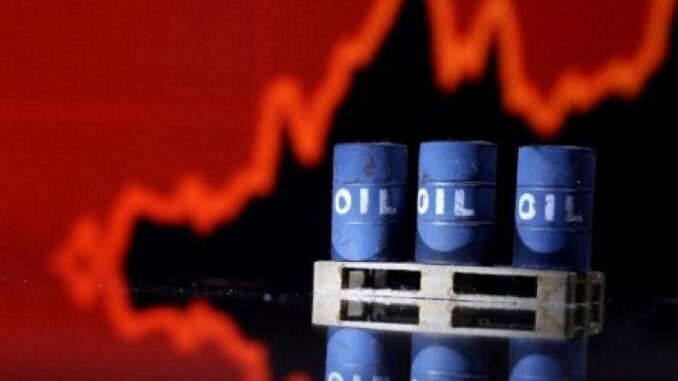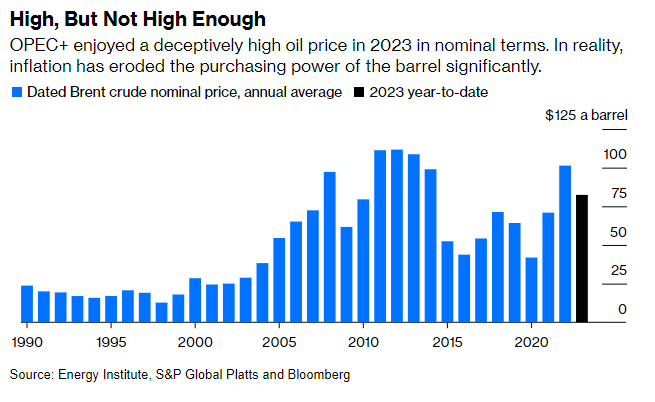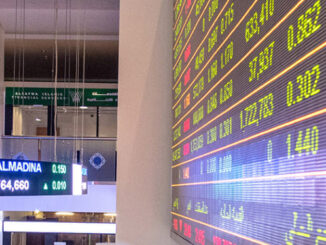
Any weakness in oil demand or increase in supply — or both — could push the market into a surplus next year.
Saudi Energy Minister Prince Abdulaziz bin Salman is apparently keen on Alexandre Dumas, often calling foes – Wall Street oil analysts and journalists alike – “musketeers.” I’m also a fan of the French novelist; but rather than D’Artagnan, I prefer The Count of Monte Cristo. Which brings me to my favorite Dumas’ quote, apposite for describing the Saudi oil strategy going into 2024:
“All human wisdom is contained in these two words — wait and hope.”
Last month, the Saudis rolled over their unilateral oil production cuts into the New Year, and convinced a few others inside the OPEC+ cartel to cut output further. Now, they wait and hope.
First, let’s recap 2023. Despite constant bearish talk about energy demand, global oil consumption grew by 2.3 million barrels a day. The final leg of the Covid-19 recovery lifted annual consumption this year to an all-time high, surpassing the previous peak set in 2019. So far, it was good for the Saudis.
The problem was on the other side of the balance: supply. First, the US shale industry defied predictions of a slowdown, posting strong annual growth. Next, Iranian oil production surged as Washington turned a blind eye to enforcing its sanctions, with Iran becoming this year’s second-largest source of additional oil. Meanwhile, Western sanctions on Moscow also proved porous, making more Russian oil available than expected. On top, Brazil, Guyana and a few other non-OPEC producers also boosted supply.
OPEC+, led by the Saudis and the Russians, responded mid-year with output cuts, which put a floor under the market. Middle East tension helped to push prices even higher in October, flirting with $100 a barrel. With a few days left to the end of the year, Brent has averaged about $82 a barrel in 2023 – not bad in nominal terms, but much lower than OPEC+ enjoyed in the past when adjusted for the surge in inflation since 2020.

So what awaits in 2024? For Saudi Arabia, it’s a wait-and-hope situation. But, in the background lurks make-or-break. If Riyadh is misreading the market — and the jury is out — it may need to make a U-turn by the end of next year.
Clearly, oil demand growth will slow as the torrid post-pandemic increases end. But, please, let’s not over emphasize the deceleration. The bears misjudged crude appetite in 2023, and I believe they’re wrong again for 2024. The International Energy Agency forecasts that oil demand would increase next year by 1.1 million barrels a day – somewhat more than expected a few months ago. The increase is in line with the 2000 to 2019 annual average of 1.2 million barrels a day, and stronger than the 1 million daily barrels between 1990 and 1999. So no, oil demand growth isn’t slowing down sharply – it is just returning to its historical norm.
Supply, however, looks less certain. In a benign scenario, with non-OPEC+ output growth roughly matching the increase in global oil demand, Saudi Arabia has probably done enough to keep prices above $70 a barrel next year. With some luck, over time it would be able to release some of the production it’s currently keeping out of the market — but no earlier than the second half of next year, meaning the cartel will likely need to prolong the cuts currently in place until the end of March through the end of the second quarter.
The above scenario underpins the wait-and-hope framework. But the margin of error for the Saudis and their allies is very small, and any weakness in demand or increase in supply — or, worse, both — could push the oil market into a surplus. For the second consecutive year, the consensus view is that US shale growth will slow. Having been wrong in 2023, I believe it’s prudent to prepare to be wrong again in 2024. Geopolitics can play both hands, providing bearish and bullish surprises on supply; as 2023 ends, conflict in the Middle East is affecting energy flows throughout the Red Sea.
On balance, I think that OPEC+ faces a greater danger from the supply side than the demand one. If a surplus emerges, particularly because the US shale industry can make money and grow production even with prices below $75 a barrel, Riyadh faces a difficult choice. Either it convinces OPEC+ to cut output even more (something I struggle to see), or accepts much lower prices. That’s why I reckon wait-and-hope could deteriorate into make-or-break.
For now, the Saudis are confident in their reading of the industry and the market. They don’t expect to face multiple years of non-OPEC+ extra supply overwhelming demand growth, as happened from 2010 to 2015 when they lost market share. The kingdom resolved that situation in 2016 with a price war against shale, flooding the market and sending oil below $30 a barrel.
In Wall Street, a growing minority see that happening again in 2024, and toward 2025 and 2026. That’s why the oil market is speculating about a “flush the market” scenario, with calls for the Saudis to launch another offensive, inundating the market and sending oil prices crashing once again. If that were to happen, it would reverberate beyond commodities, provoking turbulence in equities, bonds and currencies.
While I don’t currently buy the “flush the market” synopsis, I admit there’s a growing risk of that outcome. By the middle of 2024, the oil market could be very, very tired — of both waiting and hoping.



